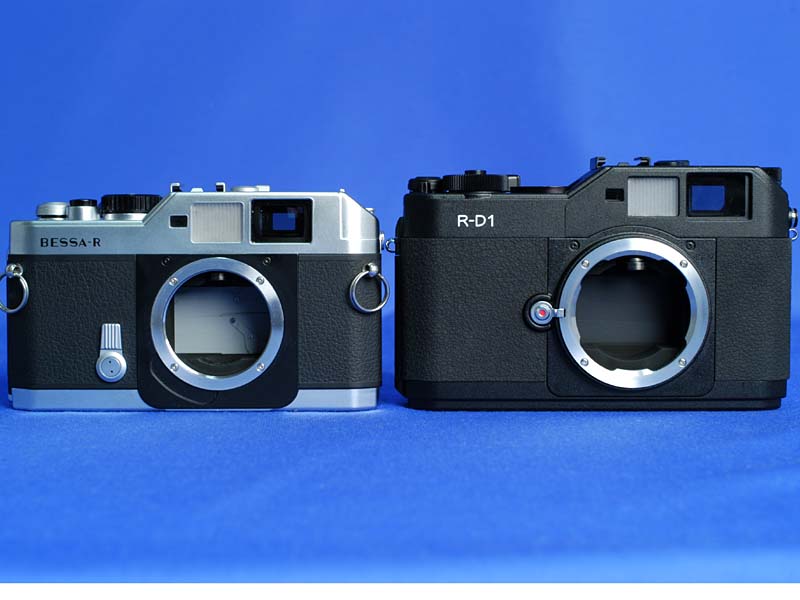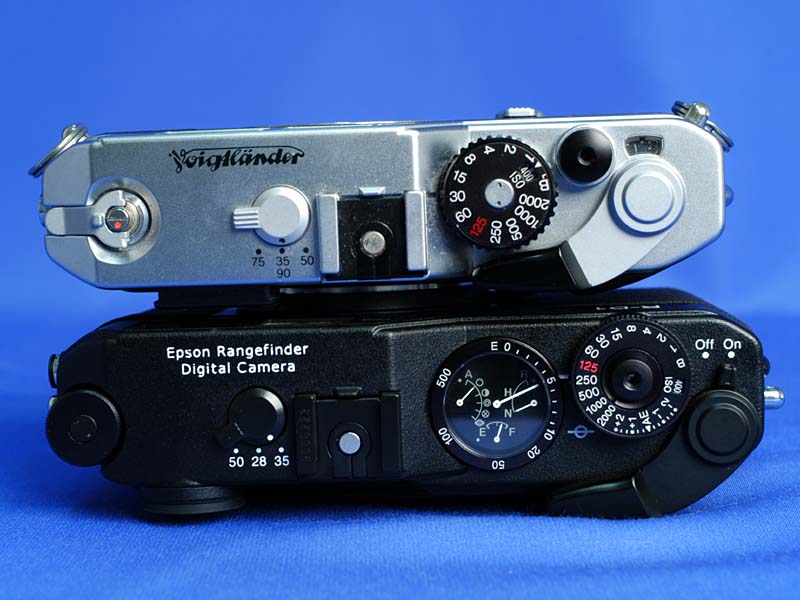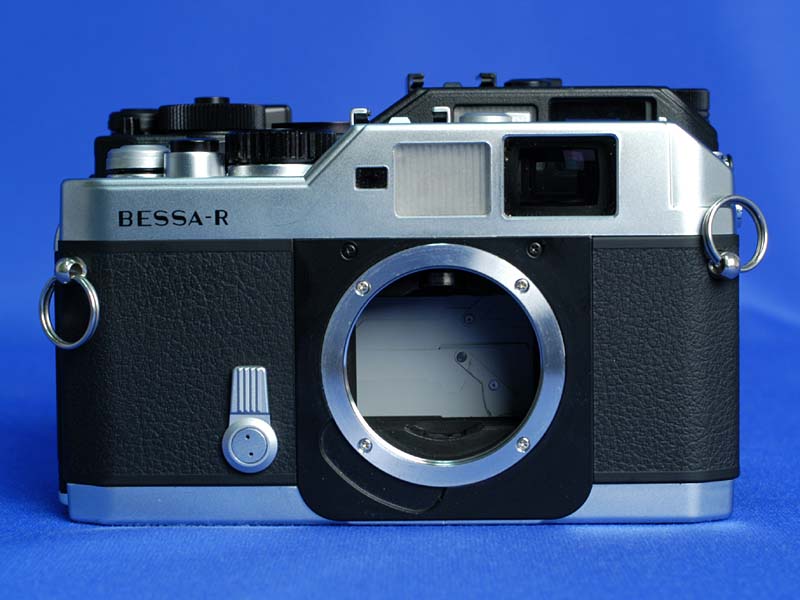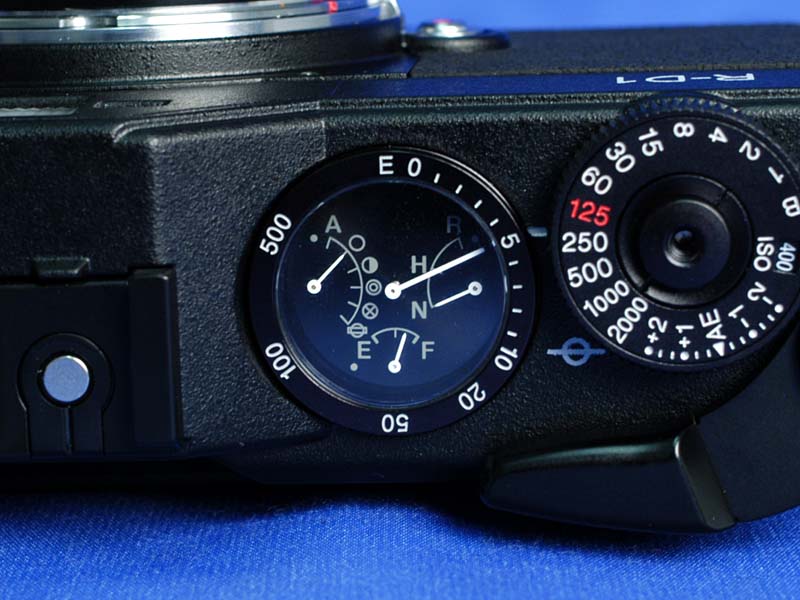Epson Launches the World's First Rangefinder Digital Camera
* Lens sold separately.
- TOKYO, Japan, March 11 –
Seiko Epson Corporation ("Epson") has launched the Epson Rangefinder Digital Camera R-D1*1, the world's first rangefinder digital camera, in partnership with Cosina Corporation.
Technical collaboration
Epson has helped transform the world of photo printing into the digital world by developing inkjet printers and other digital photo printing technologies. Among the critical technologies behind the stunning quality of Epson's digitally rendered photos is digital image processing—technology for optimizing digital data as a high-quality photo image. Digital image processing technology is already being used in Epson's printer drivers, high-resolution scanners and other input and output devices, but Epson had been looking for new potentially intriguing applications for it, as well. It was while scouting the possibilities that Epson met up with Cosina, a company that can boast some of the world's foremost original optical technologies.
Cosina has developed outstanding original optics technologies in the production of camera lenses while still maintaining a rigorous fidelity to the historic photography heritage. Epson felt that if the companies were to use the rangefinder camera platform—a platform that is being left in the wake of progress toward the digital age—and if they were to merge Epson's digital image processing technology with Cosina's advanced optics technology, they might be able to discover some completely new creative photographic possibilities. This idea led to collaboration between the two companies, with engineers from both sides paying uncompromising attention to detail during product development. Thus was born the R-D1
The R-D1 dares to swim against the high tide of fully automatic electronic digital cameras. It is a digital camera that still manages to feel like a traditional manual camera, for people who appreciate the peculiar satisfaction that comes with the ability to use an analog camera well. In other words, the R-D1 is simultaneously a state-of-the-art digital camera that offers outstanding performance and image quality, and a throwback that offers camera buffs the look and feel of a vintage film camera, as well as the joy of skillfully using their camera as a tool.
Digital camera firsts
Among many digital camera firsts, the R-D1 is the world's first rangefinder digital camera. A rangefinder is a type of camera that has a built-in device for measuring distance based on the principles of triangulation. The photographer focuses the camera by superimposing two slightly different views of a scene with the rangefinder. In general, compared to an auto-focus system, performance does not change even if lenses are swapped, and focus can be achieved quickly, accurately and with a light level that is nearly the same as the unaided eye, even in dimly lit locations. In addition, since the field of view is not blocked by the action of a shutter as it is with a single-lens reflex camera, the photographer will not miss the decisive moment.
The R-D1 is also the world's first digital camera to accept Leica L- and M-mounts*2. As such, it offers a new platform that links the future with the past. A huge number of lens types — more than 200 — have been created and sold over the long history of photography. This camera gives twenty-first century photographers a way to use these famed lenses from our photographic heritage. The new camera gives photographers the chance to develop a new cult of photography by allowing them to resurrect their familiar old lenses in a digital world.
The R-D1 also uses the world's first 1x viewfinder, enabling photographers to view scenes – including panoramas - through the camera as if they were looking at scenes using their naked eyes. The camera also has the advantage of improved focus precision compared to low magnification optical finders.
Epson = Photo
With "Epson = Photo" as its watchword, Epson is committed to bringing color to life and to the way people communicate, by aspiring to create new possibilities that expand the horizons of the digital photo market and by suggesting new ways to enjoy digital photography using advanced digital image processing technology.
The R-D1 will be exhibited at the 2004 Photo Expo, which will be held from March 19-21 at the Tokyo Big Sight.
*1 Epson Rangefinder Digital Camera R-D1 is a trademark of Seiko Epson Corp.
*2 The L-mount is adaptor-compatible.
Note: Lenses with external dimensions exceeding 20.5 cannot be used with this camera. In addition, the following lenses cannot be used (correct as of March 11, 2004)
Hologon 15mm F8, Super Angulon 21 mm F4, Super Angulon 21 mm F3.4, Elmarit 28 mm F2.8 (early models), Summicron 50 mm F2 (dual range Summicron), Hektor 50 mm F2.5, and Elmar 50 mm F3.5.
About Epson
The Epson Group increases its corporate value through its innovative and creative culture. Dedicated to providing its customers with digital image innovation, its main product lines comprise information-related equipment such as printers and projectors, electronic devices including displays, semiconductors and quartz devices, and precision products such as watches. Epson products are known throughout the world for their superior quality, functionality, compactness and energy efficiency.
The Epson Group is a network of 88,036 employees in 111 companies around the world, and is proud of its ongoing contributions to the global environment and to the communities in which it is located. Led by the Japan-based Seiko Epson Corp., which is listed on the First Section of the Tokyo Stock Exchange, the Group had consolidated sales of 1,322 billion yen in fiscal 2002.
Contacts
Corporate Communications,
+81-266-58-1705 or +81-3-3340-2637
E-mail
http://www.epson.co.jp/e/
* Lens sold separately.
- TOKYO, Japan, March 11 –
Seiko Epson Corporation ("Epson") has launched the Epson Rangefinder Digital Camera R-D1*1, the world's first rangefinder digital camera, in partnership with Cosina Corporation.
Technical collaboration
Epson has helped transform the world of photo printing into the digital world by developing inkjet printers and other digital photo printing technologies. Among the critical technologies behind the stunning quality of Epson's digitally rendered photos is digital image processing—technology for optimizing digital data as a high-quality photo image. Digital image processing technology is already being used in Epson's printer drivers, high-resolution scanners and other input and output devices, but Epson had been looking for new potentially intriguing applications for it, as well. It was while scouting the possibilities that Epson met up with Cosina, a company that can boast some of the world's foremost original optical technologies.
Cosina has developed outstanding original optics technologies in the production of camera lenses while still maintaining a rigorous fidelity to the historic photography heritage. Epson felt that if the companies were to use the rangefinder camera platform—a platform that is being left in the wake of progress toward the digital age—and if they were to merge Epson's digital image processing technology with Cosina's advanced optics technology, they might be able to discover some completely new creative photographic possibilities. This idea led to collaboration between the two companies, with engineers from both sides paying uncompromising attention to detail during product development. Thus was born the R-D1
The R-D1 dares to swim against the high tide of fully automatic electronic digital cameras. It is a digital camera that still manages to feel like a traditional manual camera, for people who appreciate the peculiar satisfaction that comes with the ability to use an analog camera well. In other words, the R-D1 is simultaneously a state-of-the-art digital camera that offers outstanding performance and image quality, and a throwback that offers camera buffs the look and feel of a vintage film camera, as well as the joy of skillfully using their camera as a tool.
Digital camera firsts
Among many digital camera firsts, the R-D1 is the world's first rangefinder digital camera. A rangefinder is a type of camera that has a built-in device for measuring distance based on the principles of triangulation. The photographer focuses the camera by superimposing two slightly different views of a scene with the rangefinder. In general, compared to an auto-focus system, performance does not change even if lenses are swapped, and focus can be achieved quickly, accurately and with a light level that is nearly the same as the unaided eye, even in dimly lit locations. In addition, since the field of view is not blocked by the action of a shutter as it is with a single-lens reflex camera, the photographer will not miss the decisive moment.
The R-D1 is also the world's first digital camera to accept Leica L- and M-mounts*2. As such, it offers a new platform that links the future with the past. A huge number of lens types — more than 200 — have been created and sold over the long history of photography. This camera gives twenty-first century photographers a way to use these famed lenses from our photographic heritage. The new camera gives photographers the chance to develop a new cult of photography by allowing them to resurrect their familiar old lenses in a digital world.
The R-D1 also uses the world's first 1x viewfinder, enabling photographers to view scenes – including panoramas - through the camera as if they were looking at scenes using their naked eyes. The camera also has the advantage of improved focus precision compared to low magnification optical finders.
Epson = Photo
With "Epson = Photo" as its watchword, Epson is committed to bringing color to life and to the way people communicate, by aspiring to create new possibilities that expand the horizons of the digital photo market and by suggesting new ways to enjoy digital photography using advanced digital image processing technology.
The R-D1 will be exhibited at the 2004 Photo Expo, which will be held from March 19-21 at the Tokyo Big Sight.
*1 Epson Rangefinder Digital Camera R-D1 is a trademark of Seiko Epson Corp.
*2 The L-mount is adaptor-compatible.
Note: Lenses with external dimensions exceeding 20.5 cannot be used with this camera. In addition, the following lenses cannot be used (correct as of March 11, 2004)
Hologon 15mm F8, Super Angulon 21 mm F4, Super Angulon 21 mm F3.4, Elmarit 28 mm F2.8 (early models), Summicron 50 mm F2 (dual range Summicron), Hektor 50 mm F2.5, and Elmar 50 mm F3.5.
About Epson
The Epson Group increases its corporate value through its innovative and creative culture. Dedicated to providing its customers with digital image innovation, its main product lines comprise information-related equipment such as printers and projectors, electronic devices including displays, semiconductors and quartz devices, and precision products such as watches. Epson products are known throughout the world for their superior quality, functionality, compactness and energy efficiency.
The Epson Group is a network of 88,036 employees in 111 companies around the world, and is proud of its ongoing contributions to the global environment and to the communities in which it is located. Led by the Japan-based Seiko Epson Corp., which is listed on the First Section of the Tokyo Stock Exchange, the Group had consolidated sales of 1,322 billion yen in fiscal 2002.
Contacts
Corporate Communications,
+81-266-58-1705 or +81-3-3340-2637
http://www.epson.co.jp/e/
JohnL
Very confused
Does anyone have an idea what this body is going to cost in the US market?
Just curious, John
Just curious, John
SolaresLarrave
My M5s need red dots!
Stephen Gandy has guessed (based on information gathered from a Japanese website) that the price may be similar to that of a Leica MP: around $2500 for the body only.
I still cannot warm up to digital, mostly because I'm lazy and don't want to "learn" all that's involved in digital photography. Hence, if I had that kind of money... I'd probably invest it in glass for my Leicas.
I still cannot warm up to digital, mostly because I'm lazy and don't want to "learn" all that's involved in digital photography. Hence, if I had that kind of money... I'd probably invest it in glass for my Leicas.
JohnL
Very confused
Tough sell, I'd guess, at that price. I'll be watching how much it gets to be discounted.
Cheers, John.
Cheers, John.
SolaresLarrave
My M5s need red dots!
Correction, it's between $ 1600 and $1800 according to some information I read in photo.net. Sorry about it!
Actually, John, that doesn't sound too bad. It's still steep, but you don't need to be among the first ones to grab one. In these cases, it always pays to wait a bit.
Actually, John, that doesn't sound too bad. It's still steep, but you don't need to be among the first ones to grab one. In these cases, it always pays to wait a bit.
JohnL
Very confused
That's why I'll be watching the discounting! Many thanks for the info.
John
John
JohnL
Very confused
GeneW
Veteran
JohnL said:
John, thanks for the link. It has some pretty interesting information.
I hate to say it, but the more I learn about this camera, the less interested I am -- and I'm a dedicated digital user when I'm not using my RF's. It's large for an RF, it uses the *wrong* storage card, and it's gonna be expensive.
For the kind of price that's being suggested, I could buy a brand new Leica M film body and maybe an extra lens.
It's been raining all day -- maybe I'm just grumpy
Gene
JohnL
Very confused
I feel much the same, but either this model will eventually be discounted or there will be a follow-on, maybe under the CV logo, at half the price. Maybe they will learn from this first try. The options like "B&W with yellow filter" strike me as unnecessary, as this can be done in software afterwards, retaining much greater flexibility.
For comparison, my G5 was initially priced at $1000. I got mine for $700 and you can now find them for $500, or maybe less. The Pro1 is about to hit the shelves at $1100 list, and can already be ordered for less than $1000. No doubt it will come down further.
These cameras are not comparable to the RD1, of course. They are intended for a different purpose. The strength of these compact digitals is their versatility - they can do nearly anything pretty decently. The strengths of the RF, which should be preserved in a digital version, are simplicity / ergonomics / speed (all the same thing, really) for pictures of people. That's not all, of course, but this is their main strength. Compared to an SLR, the RF is also smaller and lighter, but that is true of the compacts too.
Having said all this, which no doubt everyone here knows already, I think my next camera will either be an R2 or a Pro1. The Pro1, unfortunately, does not have an optical viewfinder like the G5.
John
For comparison, my G5 was initially priced at $1000. I got mine for $700 and you can now find them for $500, or maybe less. The Pro1 is about to hit the shelves at $1100 list, and can already be ordered for less than $1000. No doubt it will come down further.
These cameras are not comparable to the RD1, of course. They are intended for a different purpose. The strength of these compact digitals is their versatility - they can do nearly anything pretty decently. The strengths of the RF, which should be preserved in a digital version, are simplicity / ergonomics / speed (all the same thing, really) for pictures of people. That's not all, of course, but this is their main strength. Compared to an SLR, the RF is also smaller and lighter, but that is true of the compacts too.
Having said all this, which no doubt everyone here knows already, I think my next camera will either be an R2 or a Pro1. The Pro1, unfortunately, does not have an optical viewfinder like the G5.
John
Last edited:
M
mfs
Guest
Any idea as to price, and availability???
Interestingly, here in the U.S. we have no Cosina-Voigtlander importer. So who will import this camera?? Will it be Epson?? Who will provide service, and support??
Obviously, more questions than answers at this time.
Martin
Interestingly, here in the U.S. we have no Cosina-Voigtlander importer. So who will import this camera?? Will it be Epson?? Who will provide service, and support??
Obviously, more questions than answers at this time.
Martin
JohnL
Very confused
I don't know who does the importing, but you can get CV gear from B&H and from CameraQuest and maybe other places too.
HTH, John
HTH, John
Photo Village in NYC http://www.photovillage.com/html/shop.html is another one.
But I understand Epson intends to use its own existing US distribution for this camera, apparently putting it into the same stores as Epson printers...
But I understand Epson intends to use its own existing US distribution for this camera, apparently putting it into the same stores as Epson printers...
John Robertson
Well-known
Sorry but I just can't seem to get very excited about this, even less by the news about a Leica Digital M series. I would probably have to sell the house for that!!!
N
NoTx
Guest
Leica will also us SD memory, as they ae in the R9 back. Seems stupid really. SD is second rate for professional use versus CF.
R
Rich Silfver
Guest
Here's the R-D1 compared to a Bessa-R








Lets see, it is bigger, the looks to have the same rangefinder, but the framelines I am sure are adjusted to match the conversion factor. What is the fancy dial thingy next to the shutter speed ring?
R
Rich Silfver
Guest
GeneW
Veteran
I sure agree with that. If a professional or semi-professional picks up one of these, he or she likely is already shooting with a Nikon or Canon DSLR which takes CF cards. Interchangeability of CF cards would be preferable to having to buy a different type of card. SD is a bad decision, IMO, for both of these proposed cams.NoTx said:Leica will also us SD memory, as they ae in the R9 back. Seems stupid really. SD is second rate for professional use versus CF.
Gene
S
shaaktiman
Guest
This looks truly amazing. I understand the reluctance of many rangefinder people to get into digital cameras. I mean, we're the type who eschew anything requiring electricity (except maybe meters) in favor of mechanical simplicity and reliability.
However, the fact remains that digital is slowly taking over. Currently no (or very few) professional journalists use film anymore and fewer and fewer travel photographers are as well. While it has its disadvantages, digital is becoming the mainstay for any brand of photography that requires immediacy or ease of integration into a digital environment. And it doesn't look like anyone is considering reverting back to film anytime soon either, digital is cheaper and more convenient for both photographers and editors. So, bearing that in mind, if you want to break into journalism or travel, (as I do) I find it very reassuring to know that one can use the leica/voigtlander glass that I already have and trust over having to switch formats completely.
Besides, then my bessa can take a ride and share some of the action for when I'm noodling around on my own projects and quality takes precedence over speed.
just my 2¢
However, the fact remains that digital is slowly taking over. Currently no (or very few) professional journalists use film anymore and fewer and fewer travel photographers are as well. While it has its disadvantages, digital is becoming the mainstay for any brand of photography that requires immediacy or ease of integration into a digital environment. And it doesn't look like anyone is considering reverting back to film anytime soon either, digital is cheaper and more convenient for both photographers and editors. So, bearing that in mind, if you want to break into journalism or travel, (as I do) I find it very reassuring to know that one can use the leica/voigtlander glass that I already have and trust over having to switch formats completely.
Besides, then my bessa can take a ride and share some of the action for when I'm noodling around on my own projects and quality takes precedence over speed.
just my 2¢
If this camera hit the $2,000 barrier I bet it would be a reasonable seller. At that price I could be forced to buy one by my family that wants be to join the digital crowd. At $3,500 it is hard to justify; about the same as a Black Nikon S3-2000.
I have paid more for Digital cameras for work; but that was not MY money. I could not justify one of these cameras for work; a place where I spent $12,000 on one of the first digital SLR's, a Kodak DCS-200IR in 1990; two years ago bought two D1x's with one of every micro-Nikkor lens in production; and last year bought a second Canon 50mm F0.95 lens for an IR sensor after the engineers saw what my lens did on their IR camera.
Anybody got a plan to get one of these at $3,500?
I have paid more for Digital cameras for work; but that was not MY money. I could not justify one of these cameras for work; a place where I spent $12,000 on one of the first digital SLR's, a Kodak DCS-200IR in 1990; two years ago bought two D1x's with one of every micro-Nikkor lens in production; and last year bought a second Canon 50mm F0.95 lens for an IR sensor after the engineers saw what my lens did on their IR camera.
Anybody got a plan to get one of these at $3,500?
Last edited:
Share:
-
This site uses cookies to help personalise content, tailor your experience and to keep you logged in if you register.
By continuing to use this site, you are consenting to our use of cookies.


